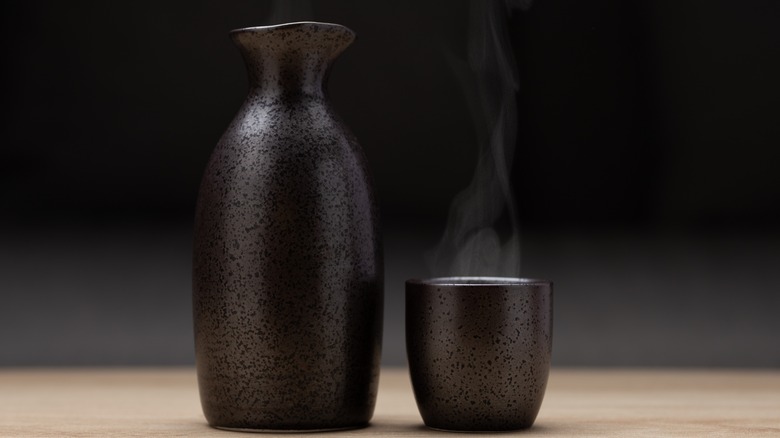The Easiest Way To Drink Warm Sake Right From Your Home
When it comes to sake, it's time to turn up the heat. Let us begin by saying that not all sake should be served warm, however, unlike fresh and delicate varieties, aged sake benefits the most from being heated. In addition to producing a silkier texture, warmer temperatures highlight nuanced flavors and aromas all while amplifying sweetness and softening bitterness. If sipping on warm aged sake sounds like a slice of heaven, then learning how to properly heat the fermented rice beverage at home is a must.
At restaurants, sake is usually warmed following a bain-marie method. Once sake is poured into a tokkuri (serving vessel), the tokkuri is placed into a pot of boiling hot water and is left to gradually heat up to the desired temperature. Despite the fact that this process guarantees the heat is evenly distributed, it requires both tools and time, which you might not have at home. Instead, for speedier results, sake can be warmed in the microwave.
Quick and convenient, executing the microwave method is easy and won't cause any damage to the beverage. All you need to do is pour sake into a microwave-safe container until it's 90% full. Cover it with plastic wrap to preserve aromas and then place it in the microwave for 15 seconds. Give the sake a swirl to redistribute residual heat before repeating the process several times until you've reached the ideal warmth, as indicated with a thermometer.
How to serve sake warm (and keep it that way)
Personal preference aside, warm sake should reach somewhere between 104 to 113 degrees Fahrenheit when heated. Although the time it takes to achieve these temperatures may depend on the wattage of your microwave and the material of your container, the process generally takes about a minute or so to complete. Once your sake is nearly steamy, you can begin pouring.
Since maintaining heat is key, it's best to serve warm sake in little ceramic or porcelain cups. This is because smaller surface areas coupled with the right materials will allow for better heat retention, meaning that the last sip you take will be just as warm as the first. Naturally, this is why sake should also be served in flasks made of the same material, after being heated in the microwave to avoid cracking. Otherwise, you can invest in a sake set with a warmer. Additionally, it's wise to pour only what you plan on drinking, rather than warming the whole bottle and then having to reheat it once more as temperatures start to drop.
An overall effortless way to serve sake at home, microwaving allows you to warm a cup of sake in seconds. With less time and energy exerted on heating the beverage, this frees up more time to think about pairing sake. Our advice? Match warm with warm and accompany sake with grilled meat, fried tempura, or savory soup!

